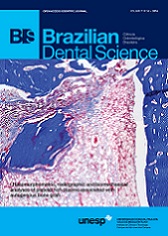Distance learning in dental radiology: Immediate impact of the implementation
DOI:
https://doi.org/10.14295/bds.2014.v17i4.930Abstract
Objective: This study assessed the immediate impact in terms of learning of the dento-maxillomandibular radiographic anatomy in intraoral periapical radiographs after entire replacement of the method of classroom learning by the distance learning using the Moodle platform. Material and Methods: The teaching of this subject by traditional educational setting in classroom was made until the first semester of 2011, “A class” (AC), using radiographic slabs from duplicated films. In the second semester of 2011, “B class” (BC), these radiographic slabs were digitalized, creating the Moodle e-course about dento-maxillomandibular anatomy in intraoral radiographs for distance learning. The impact was assessed by comparison of scores of students from two distinct classes, AC (N=60) and BC (N=62), after application of a similar test with all content of the topic of dento-maxillomandibular anatomy, using T-Student unpaired test (?=0.05). A voluntary and unidentified questionnaire with 12 questions, developed in Google Docs spreadsheets, was used to evaluate the acceptance of students for this e-course. Results: No significant differences (p>0.05) were observed in scores of the students from two classes. Among other questions, all students of BC who completed the questionnaire had interest in content of the available material in e-course, and their satisfaction level on a scale from 0 to 10 had a mean of 8.47 (SD=1.69). Conclusion: The method of distance learning of this subject using the Moodle platform can be utilized with same educational results as of those obtained from a traditional educational setting.Downloads
Downloads
Published
How to Cite
Issue
Section
License
Brazilian Dental Science uses the Creative Commons (CC-BY 4.0) license, thus preserving the integrity of articles in an open access environment. The journal allows the author to retain publishing rights without restrictions.
=================




























